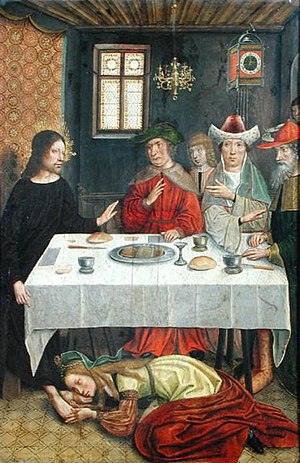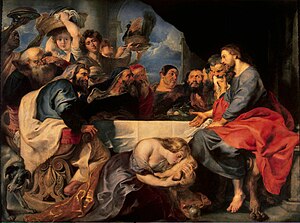Reblogged from Chief of the least:
A PROSTITUTE TEACHES ME HOW TO WORSHIP
As Christians, we often spend a lot of time wondering what is wrong with us.
We hear of martyrs on foreign soil laying down their lives for the gospel in bloody extravagant fashion. Church history testifies of men and women who stood against fierce political and social opposition and proclaimed boldly the foolishness of the cross. In our bible reading the fearless radical passion of the early church in the book of Acts is an indictment on our listless and dry spiritual estate.
Even reading a popular book calling us to “Radical” gospel commitments doesn’t necessarily bring the quick spiritual fix we long for.
It’s enough to make any solid sincere saint at the least question their own fruit, and at the most question their very salvation.
All of this begs the question.
Thankfully, as is always the case with the most important questions, the Bible is forthcoming with a more than adequate answer. It’s found in Luke 7:36-50:
When one of the Pharisees invited Jesus to have dinner with him, he went to the Pharisee’s house and reclined at the table. A woman in that town who lived a sinful life learned that Jesus was eating at the Pharisee’s house, so she came there with an alabaster jar of perfume. As she stood behind him at his feet weeping, she began to wet his feet with her tears. Then she wiped them with her hair, kissed them and poured perfume on them. When the Pharisee who had invited him saw this, he said to himself, “If this man were a prophet, he would know who is touching him and what kind of woman she is—that she is a sinner.”
Let’s stop there for now.
Where does such passion, boldness, and extravagant worship come from?
Party Like A Morning Star
In the verse right before this scene (Luke 7:34) Jesus speaks of eating with the “wrong people.” The Sinners and tax collectors were despised by the religious establishment. One of the Pharisees charges against Jesus was that he threw the best parties (“a drunkard”) and invited the lowest classes of a people.
They probably were jealous they weren’t invited.
Jesus turns that theory on its head in the very next scene. Being no respecter of persons, Christ eats with the “right” person in v. 36. Pharisees were the creme de la creme of society, pillars of the first century Israeli religious system. The Pharisees were OCD in their religious zeal. They fasted frequently and even tithed out of their spice racks.
In v. 36 Simon the Pharisee invites Jesus to dinner. Dinner was a sign of intimate acquaintance in ancient Israel culture. A gesture of supreme respect towards the person invited.
Is it possible to pay outward respects to Christ and inwardly oppose him?
It takes no time for a broken vessel to rain on Simon’s party.
Party Foul Of Kanye West Proportions
In v.37 we have a very public “sinner” show up to the Pharisee’s house. The phrase “woman of the city” usually connotes sexual sin, which was probably committed as a prostitute. In that day, women were second class citizens on the level of children. For a woman to show up to a man’s dinner party uninvited was a serious party foul.
For a known prostitute to show up at a Pharisee’s dinner party uninvited was a colossal Kanye Westesque error.
The woman brings with her what is likely her most valuable possession, an alabaster flask of perfume. The expensive stone flask was probably used for her line of work. In a profound way, the jar contained her very livelihood. It was worth a healthy portion of her salary for the entire year.
Yet she pours it out in a reckless display of love.
Her only earthly security.
Her 401K Plan.
And then something even more stunning happens.
Because of our lack of historical context, the cultural significance of v. 38 is lost on us.
She washes Jesus’s feet with her glory
A woman’s hair had a weighty impact on her identity in Jewish culture.
In 1 Cor. 11:15 Paul calls a woman’s hair her “glory.”
The first century Jewish woman kept her hair up all her life. But on her wedding night when she was standing before her husband for the first time the man would reach up and take her hair down. Before the marriage was officially consummated the new husband would first see his wife’s long hair fall around her bare shoulders and back, and he would behold her there, standing in all her “glory.” Because of these implications it was scandalous for a woman to have her hair down before other men in public places.
But this woman does not care that she scandalizes the mind of mere men. She is on a solemn mission to serve at the feet of her tender Savior.
Her hair is down, she is vulnerable, she lays it all before the feet of the only man who will never use and abuse her.
And she uses her alabaster jar, her life savings plan, her only resource of earthly value and pours it on the feet of Jesus. The sandaled, dusty, unkempt feet of love. This was a slave’s job. She does it with tearful joy. Her tears were the soap that anointed the Savior’s feet.
Worship is a deeply emotional response to Christ. It is not just that, but it at least has that heartfelt component in it. Dignified stoicism is not a virtue lauded by Jesus.
This passion, boldness, and extravagant worship was a response she couldn’t hold back, no matter how her culture condemned her.
The gaze of the religious cut her to pieces. But she was pierced only by the gaze of One.
We’ll answer the original question at hand in the next post. The question(s) for now are:
What is holding me back from unhindered displays of worship for my Jesus?
What can this prostitute teach me about costly love?
Do I identify more with the Pharisee than the prostitute in this scene?
Peace and Grace til next time.
Bryan Daniels
http://chiefofleast.com/2012/03/31/a-prostitute-teaches-me-how-to-worship/
This entry was posted on March 31, 2012, in Random. Bookmark the permalink. 41 Comments
Related articles
- The Woman Who Loved Deeply (sethparr.wordpress.com)
- February 28 – I Must Not Be Quick To Judge (lelandfleming.wordpress.com)
- A Pharisee, A Sinful Woman, and the Savior (brakeman1.com)
- He’s about forgiveness (wordsofgrace.wordpress.com)
- Holy Week 2012 (ptl2010.com)

















No comments:
Post a Comment